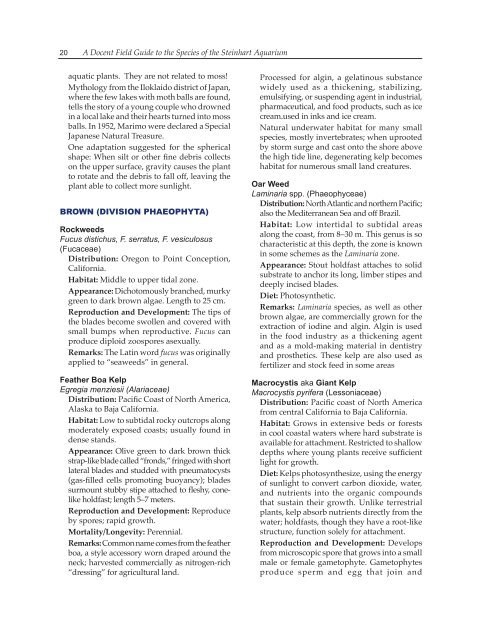THE STEINHART AQUARIUM - Gulf of Guinea Science ...
THE STEINHART AQUARIUM - Gulf of Guinea Science ...
THE STEINHART AQUARIUM - Gulf of Guinea Science ...
Create successful ePaper yourself
Turn your PDF publications into a flip-book with our unique Google optimized e-Paper software.
20 A Docent Field Guide to the Species <strong>of</strong> the Steinhart Aquarium<br />
aquatic plants. They are not related to moss!<br />
Mythology from the Iloklaido district <strong>of</strong> Japan,<br />
where the few lakes with moth balls are found,<br />
tells the story <strong>of</strong> a young couple who drowned<br />
in a local lake and their hearts turned into moss<br />
balls. In 1952, Marimo were declared a Special<br />
Japanese Natural Treasure.<br />
One adaptation suggested for the spherical<br />
shape: When silt or other fine debris collects<br />
on the upper surface, gravity causes the plant<br />
to rotate and the debris to fall <strong>of</strong>f, leaving the<br />
plant able to collect more sunlight.<br />
BROWN (DIVISION PHAEOPHYTA)<br />
Rockweeds<br />
Fucus distichus, F. serratus, F. vesiculosus<br />
(Fucaceae)<br />
Distribution: Oregon to Point Conception,<br />
California.<br />
Habitat: Middle to upper tidal zone.<br />
Appearance: Dichotomously branched, murky<br />
green to dark brown algae. Length to 25 cm.<br />
Reproduction and Development: The tips <strong>of</strong><br />
the blades become swollen and covered with<br />
small bumps when reproductive. Fucus can<br />
produce diploid zoospores asexually.<br />
Remarks: The Latin word fucus was originally<br />
applied to “seaweeds” in general.<br />
Feather Boa Kelp<br />
Egregia menziesii (Alariaceae)<br />
Distribution: Pacific Coast <strong>of</strong> North America,<br />
Alaska to Baja California.<br />
Habitat: Low to subtidal rocky outcrops along<br />
moderately exposed coasts; usually found in<br />
dense stands.<br />
Appearance: Olive green to dark brown thick<br />
strap-like blade called “fronds,” fringed with short<br />
lateral blades and studded with pneumatocysts<br />
(gas-filled cells promoting buoyancy); blades<br />
surmount stubby stipe attached to fleshy, conelike<br />
holdfast; length 5–7 meters.<br />
Reproduction and Development: Reproduce<br />
by spores; rapid growth.<br />
Mortality/Longevity: Perennial.<br />
Remarks: Common name comes from the feather<br />
boa, a style accessory worn draped around the<br />
neck; harvested commercially as nitrogen-rich<br />
“dressing” for agricultural land.<br />
Processed for algin, a gelatinous substance<br />
widely used as a thickening, stabilizing,<br />
emulsifying, or suspending agent in industrial,<br />
pharmaceutical, and food products, such as ice<br />
cream.used in inks and ice cream.<br />
Natural underwater habitat for many small<br />
species, mostly invertebrates; when uprooted<br />
by storm surge and cast onto the shore above<br />
the high tide line, degenerating kelp becomes<br />
habitat for numerous small land creatures.<br />
Oar Weed<br />
Laminaria spp. (Phaeophyceae)<br />
Distribution: North Atlantic and northern Pacific;<br />
also the Mediterranean Sea and <strong>of</strong>f Brazil.<br />
Habitat: Low intertidal to subtidal areas<br />
along the coast, from 8–30 m. This genus is so<br />
characteristic at this depth, the zone is known<br />
in some schemes as the Laminaria zone.<br />
Appearance: Stout holdfast attaches to solid<br />
substrate to anchor its long, limber stipes and<br />
deeply incised blades.<br />
Diet: Photosynthetic.<br />
Remarks: Laminaria species, as well as other<br />
brown algae, are commercially grown for the<br />
extraction <strong>of</strong> iodine and algin. Algin is used<br />
in the food industry as a thickening agent<br />
and as a mold-making material in dentistry<br />
and prosthetics. These kelp are also used as<br />
fertilizer and stock feed in some areas<br />
Macrocystis aka Giant Kelp<br />
Macrocystis pyrifera (Lessoniaceae)<br />
Distribution: Pacific coast <strong>of</strong> North America<br />
from central California to Baja California.<br />
Habitat: Grows in extensive beds or forests<br />
in cool coastal waters where hard substrate is<br />
available for attachment. Restricted to shallow<br />
depths where young plants receive sufficient<br />
light for growth.<br />
Diet: Kelps photosynthesize, using the energy<br />
<strong>of</strong> sunlight to convert carbon dioxide, water,<br />
and nutrients into the organic compounds<br />
that sustain their growth. Unlike terrestrial<br />
plants, kelp absorb nutrients directly from the<br />
water; holdfasts, though they have a root-like<br />
structure, function solely for attachment.<br />
Reproduction and Development: Develops<br />
from microscopic spore that grows into a small<br />
male or female gametophyte. Gametophytes<br />
produce sperm and egg that join and


